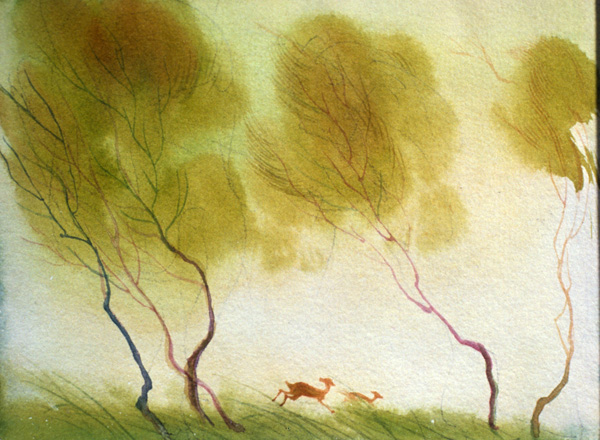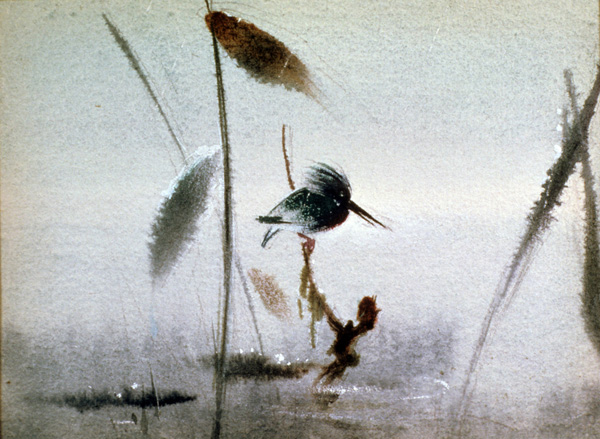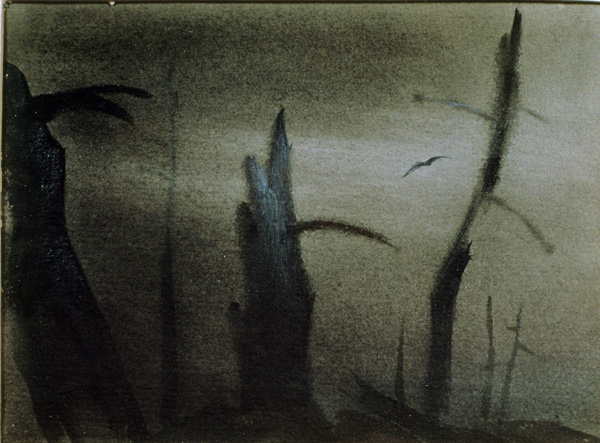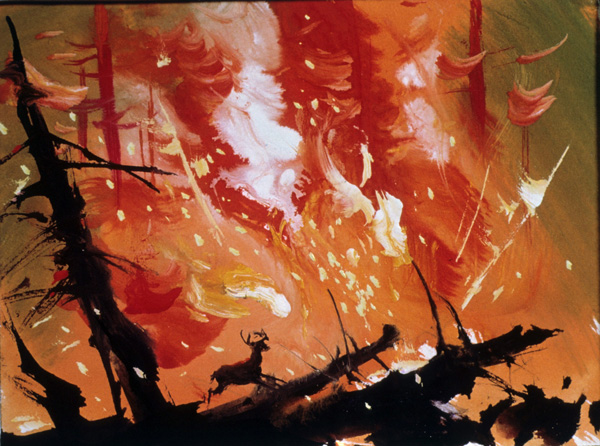
INTERVIEWS
| One of the hundreds of sketches Ty Wong made as the principal styling artist for Bambi. The sketches reproduced on this page were taken from photographic slides that Wong provided; he said in a letter that most of the actual drawings were 3 3/4 x 5. "I may have done some larger," he said, "but I did hundreds in 3 3/4 x 5." |
Tyrus Wong
An Interview by Michael Barrier
I interviewed Ty Wong on January 13, 1979, at his home in Sunland, California—a lovely home, as I remember it, not just Asian in character but with a refinement that testified that an artist lived there. In the interview, Wong spoke with an accent (he was a Chinese immigrant, born in Canton), but the transcript doesn't reflect any of the broken English that turns up in quotations from later interviews. Perhaps I smoothed off those rough edges in transcribing (I still have the tape of our interview, but I haven't consulted it for this post), but there are no such lapses in the several letters I received from him. I sent Wong the transcript of the interview in 1982, and he returned it with no changes other than to correct one name.
Fifteen years after I interviewed Ty Wong, John Canemaker interviewed him in 1994 for his book Before the Animation Begins: The Art and Lives of Disney Inspirational Sketch Artists (Hyperion, 1996), still the best single source on Wong's life and career. There was talk in that later interview of the racial animus Wong experienced at various times in his life, as a young immigrant and as a Disney artist, but nothing of the sort surfaced in my interview with him. No doubt that was because I focused less on his personal history than on how his work fit into the larger scheme of work on Bambi. When other Disney people talked to me or Milt Gray about Wong or his work, the worst anyone could say was that he was so good that he displaced Harold Miles as the principal stylist for Bambi.
Wong wrote of the roles he and Miles played in work on Bambi in a letter to me in September 1982: "While Harold Miles and I were in Bambi, he worked in his style and I in mine. He was a great admirer of Frank Brangwyn and Dean Cornwell [highly regarded illustrators and muralists—Brangwyn British, Cornwell American—who were active in the first half of the twentieth century]. Harold was known as 'tree' man. He could draw and paint any tree." In other words, Miles worked in a more literal style that lost favor once Walt Disney saw Wong's delicate and allusive sketches.
Given that Wong's work was almost universally admired, why was he laid off in September 1941, after the strike? I'm sure it was because he was so closely identified with Bambi, and very little work remained to be done on that feature—certainly very little that called for a stylist's input—by the time the strike ended. He was one of many excellent artists who lost their jobs as the Disney studio contracted.
Barrier: I guess the first question is how you came to be associated with Bambi.
Wong: After our first girl was born, I had to have a job, so I went into Disney. I didn't know anything about the industry then, so they put me in inbetweening, and I did that for a while.They were very nice; I think the fellow's name was John Dunn—he was kind of a teacher, and George Drake was the head of [inbetweening] . They were doing everything to encourage me, but inbetweening Mickey Mouses wasn't my cup of tea at all. When I got home, my eyes would feel like a couple of tennis balls, after looking at that light [on the light board].
Barrier: Had you been painting on your own before then?
Wong: I was doing a lot of painting, and exhibiting. Then I said, this inbetweening is for the birds. I heard they were doing Bambi, so, on my own free time, I did a lot of sketches of Bambi, with the forest background, and so forth, and took them in to the studio. I think Phil Dike had something to do with that, and he looked at [Ty's sketches] and he said, "What did you say you're doing now?" "I'm doing inbetweens." "I think you're in the wrong department." They talked it over, and they said, maybe we ought to put this guy working on Bambi, it seems to be perfect for his style, and so forth. I know Gus Tenggren was doing something on [Bambi], and Harold Miles; and then Lee Blair. I started making all these sketches, and that's how I got into keying; later on, they said , "Maybe you could key the whole picture." That was fun—complete freedom, that's ideal.
Barrier: Did you go over to Seward Street?
Wong: Yes. At first I was doing inbetweening over there [at the Hyperion studio], and then we were working [on Bambi] over there for a while, and then they moved the whole thing over to Seward Street. We were upstairs, Harold Miles and myself and a fellow who later became an art director for a couple of major pictures. [Ty said that the members of his training group of inbetweeners included Norman Wright, Eric Gurney, Al Hubbard , and John McLeish.]
Wong: We were all in the same group in the annex, over on Hyperion.
Barrier: As inbetweeners.
Wong: Yes. We had a lot of fun there. Then we moved over to Seward Street, and we had a great time there, too. All together, I think I worked three and a half years on Bambi.
Barrier: When did you start at Disney's?
Wong: '37 or '38, before World War II. [According to Robert Tieman, then of the Disney Archives, Wong's dates at Disney were March 16, 1938, to September 12, 1941, the latter the date when many other Disney artists were laid off.] I was with Warner Bros. then [during the war]. I never did finish Bambi, [because] the strike came on.
Barrier: Bambi was started right after Snow White. I think it was early in 1938 when Perce Pearce and the others went over to Seward Street.
Wong: Perce Pearce was the first director on it. I remember that he always said he wanted to get the feeling of "tender young spring grass."
 Barrier: I've heard that Perce Pearce and Larry Morey tended to rhapsodize about what they wanted in the picture...
Barrier: I've heard that Perce Pearce and Larry Morey tended to rhapsodize about what they wanted in the picture...
Wong: We did a lot of sketches, trying to get a very poetic quality into the thing. But somehow a lot of them ended up on the cutting-room floor; it was one of those things . There's one scene I thought was quite nice—it was one of my favorites—of a little mouse, a field mouse, he gets up in the morning and stretches and yawns, then he sees this huge drop [of dew] come down there and he picks it up [and washes his face with it]. Things like that—and then the birds start waking up and fly into the sky, back and forth—real poetic. I remember Lew Keller working on that, and we were very sorry that it didn't get in. But somehow they always managed to get some of the fanny gags in there. I guess that's a selling point; I don't know.
Barrier: I've heard that Walt himself would come over and look at the boards and want to emphasize things, or add things, like that. Were you with Walt when he would see the boards?
Wong: Sometimes, yes.
Barrier: Was that your impression of what he was doing?
Wong: Well, I guess his idea was that it's a good old standby, it sold before and now it's just as good. I suppose I don't blame him, in a lot of ways. But, anyway, some of the things got in and—it's just like any picture.
Barrier: About how long did you work at Disney's as an inbetweener before they sent you over to Bambi?
Wong: A few months, I would say. Not too long.
Barrier: So you probably started on Bambi sometime in 1938.
Wong: Yes, I guess so. Harold Miles and I keyed the whole picture; it was really nice.
Barrier: But at first you were just one of several artists making atmospheric sketches, and then they sort of made you the man in charge?
Wong: Yes, they sort of followed my style, more or less—sort of in between oriental and occidental, a kind of unusual style. It's very hard to control, when you have so many people working on it; I didn't paint the actual backgrounds. If I could get 2 per cent in there, I'd feel lucky.
Barrier: This touches on something I wanted to ask you: how much the final film reflected your styling of it.
Wong: Not the whole film; just a certain amount of it.
Barrier: Were there any sequences or parts of the film that were really close to what you had in mind?
Wong: I would say that when Bambi gets out early in the morning, out in the forest for the first time, I would say that [is close to Ty's conception]. I was trying to get [that feeling of] early morning dew.
[In looking through some of his sketches for Bambi, Ty said he thought that the forest-fire sequence also was close to what he had in mind.]
Wong: Before the picture was finished , the strike came on. I said, well, I don't think I can go out; I'm going to be a good boy and stay in. What happens? They won the strike, and I got canned.
Barrier: Of course, you were principally styling the picture; did you do any work at all directly on the backgrounds themselves? Background painting, or anything of that kind?
Wong: No, I would say it was mostly just keying the picture. I don't believe I ever did an actual background. They had guys like Art Riley and Claude Coats—they were an entirely different department.
Barrier: How closely did you work with the layout men, like Dave Hilberman and John Hubley?
Wong: Not too much: that was sort of out of my range. I didn't want to be stepping on someone else's toes. That's why I say if you can get 2 per cent in there, you're doing very well. That fellow, Zack Schwartz—he was a layout man—he followed pretty close, trying to keep it simple and still trying to catch the feeling.
Barrier: But you didn't keep an eye on the layout men.
Wong: No. You can't keep it that [much] under control: there are too many people working, and I hate to be the bad guy—you know, who does he think he is? I just did my bit, and I had a lot of fun doing it.
Barrier: Of course, in 1940 Dave Hand took over the picture from Perce Pearce. Did that make any difference as far as you were concerned?
Wong: Dave Hand more or less followed Walt's ideas, I think. As a matter of fact, it seems to me that when he took over, then we had that spring fanny-gag concept. But I don't know.
Barrier: So the poetic things that Perce Pearce was trying to get kind of went out the window when Dave Hand took over?
Wong: Yes, a lot of things they somehow threw out. A lot of technical things—"we want to get that but we can't get it," and so forth. Certain things in the film are good, but a lot of things I'd just as soon not have in there.
Barrier: So for the three and a half years you worked on Bambi, styling was really your only job.
Wong: Yes, I did hundreds and hundreds [of sketchesj. And I wasn't the only one doing it; there were some other guys doing it, too. But I think I had more sketches than anybody else.
Barrier: You mentioned Harold Miles...
Wong: Harold Miles, and also Maurice Noble, and I think Stan Spohn did some of them, and Mel Shaw.
Barrier: Would they do a storyboard sequence and then call you in and say, "Here's what we're planning, can you give us some sketches to key this?" Your sketches are designed for certain parts of the picture, so you must have had some contact with the story work.
Wong: I read the script, and then, from sequence to sequence, I'd go through it and key it—give them an idea. I'd done my job; whether they followed it was something else.
Barrier: So you were working from a written script, as opposed to having any contact with the story men.
Wong: Yes. Like the fire sequence—I painted a lot of fire pictures, so they could follow them. If they didn't follow them, I couldn't...
Barrier: So you were doing all these sketches from a general outline of the story before they actually did the detailed story boards.
Wong: Yes. The storyboard was usually very rough, anyway.
Barrier: So you were dealing with the picture in very general terms...
Wong: Very.
Barrier: ...not in terms of any specific action going on, but just the general feeling...
Wong: Always the general feeling—atmosphere.
Barrier: All the detailed work of working out a specific background for a specific scene...
Wong: For instance, maybe Bambi has to step on a tree, so they have to paint something on there.
Barrier: You weren't concerned with that kind of detail.
Wong: No, no. I'm just interested in the whole feeling of the thing, from beginning to end.
Barrier: The sketches you've shown me are quite small. Did you work generally in that size?
Wong: About that size. Once in a while I'd do a large one, but mostly this size, because we wanted to have [the sketches] in continuity, how one sequence flowed into another.
Barrier: These are watercolors...
Wong: Right.
Barrier: Did you work with other materials at all, or was all of your work done in watercolors?
Wong: On Bambi? Mostly watercolors.
Barrier: Each of your sketches has a dominant color. Did you think of the whole picture in terms of a progression of colors?
Wong: Well, for the fire sequence, the dominant color had to be orange or red or something like that. For spring, everything is light and airy and delicate.
Barrier: Would it be safe to say that you didn't think of a progression of colors? I've seen, for example, something from Fantasia where the artist had indicated how the colors would change, in a natural progression, from one sequence to the next, in a gradual, harmonious transition. Did you think in those terms at all?
Wong: No, I was really thinking in terms of setting the mood of the picture.
Barrier: You wouldn't worry about whether you were having a predominantly green sequence before...
Wong: No, no, that didn't worry me. Mainly it was the mood. If a particular color would give me the mood I wanted, I'd use it. For the spring sequence, everything is light and gay—I was thinking in terms of bright greens and yellows, things like that—uplifting. After the fire, everything's gray—charcoal.
Barrier: Was there any talk, before the strike, of your going onto some other project? You must have been thinking ahead toward the end of your work on Bambi by that time; was there any thought of what you would do next?
Wong: No, somehow I didn't think ahead, because the picture wasn't over. After I got canned, a friend of mine who worked with me on Bambi, Travis Johnson, was at a major studio, Warner Bros., and he called me up and said, "Why don't you come work as a sketch artist?" So I went into Warners. In fact, it was these sketches [for Bambi] that got me into Warner Bros, And I stayed there more than twenty years.
Barrier: So you never got back into animation again.
Wong: No, after that I stayed in a major studio. I liked Disney very, very much, compared to the major studio. I liked the people at Disney. Somehow, in a live-action studio, the people are more superficial than at Disney. At Disney, we had a whole bunch of artists together, and we had a hell of a lot of fun, and we all seemed to understand each other. People were more sincere.
Barrier: Did you ever think about trying to get back into Disney's?
Wong: No, when I went into Warner, I found that it was quite interesting; although I didn't like the people as well, the picture, from the production end, was interesting. Maybe you worked on a picture for a month or two months, and then the next picture would have an entirely different atmosphere. I loved working on westerns and pirate pictures—colorful and exciting. I loved those things, I loved action stuff. I was over at Republic studio for a while, doing Roy Rogers pictures and John Wayne pictures; I worked on quite a few John Wayne pictures. Horses galloping, and desert [scenery] , and whatnot. And when you got tired, you could go down to the stage and watch them shoot.


[Posted January 13, 2017]
